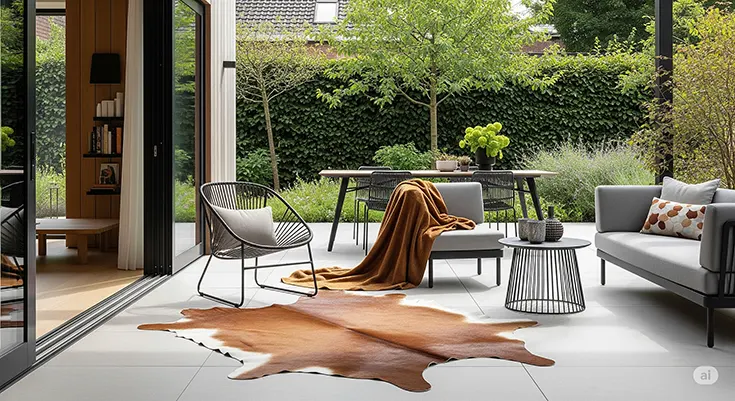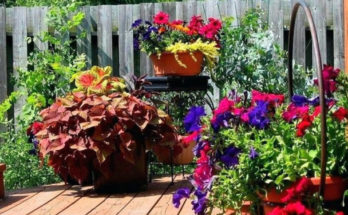As summer arrives across the UK, many households start to look at their outdoor spaces with fresh intent. The patio, once merely a passageway to the garden, becomes a place to entertain, relax, work, or enjoy the warm breeze with a book and a cup of tea. Garden rooms that might have been dormant in colder months now offer a quiet refuge, free from the noise of the house. The shift in how these outdoor and semi-outdoor spaces are used naturally leads to a change in their styling. Gone are the days of simple plastic chairs and bare floors. Instead, people are bringing the indoors out with layered textiles, comfortable seating, and, increasingly, the addition of rugs. But not just any rugs—natural hide rugs have become a surprisingly elegant and functional choice for creating sophisticated summer sanctuaries.
Hide rugs, long used in interior settings for their tactile luxury and distinctive aesthetics, are now being incorporated into garden rooms, under-covered pergolas, and even in semi-open verandas. Their ability to merge rustic charm with modern elegance makes them ideally suited for spaces that serve as a bridge between the indoors and outdoors. Whether it’s a whole cowhide rug spread under a wrought-iron coffee table or a smaller sheepskin laid at the foot of a bench in a conservatory, the addition of these natural pieces instantly elevates the space. Their beauty lies in the irregular shapes, the variation in tone, and the individuality of each piece, offering something that synthetic outdoor mats can’t replicate.
There is a sense of quiet luxury that comes with placing a hide rug in an outdoor living area. It doesn’t shout for attention. Instead, it quietly grounds the space, offering a softness underfoot that’s unexpected in these typically hard-floored environments. Natural hides complement decking, flagstones, and even tiled floors, providing both a visual and tactile contrast that brings balance to the design. This contrast can be especially striking when the rest of the space is kept neutral—featuring stoneware pots, rattan furniture, and wooden beams—allowing the natural tones of the rug to become a subtle centrepiece.
One of the most effective ways hide rugs are used outdoors is to help define specific zones within a larger space. On an expansive terrace or within a sprawling garden room, it can be hard to create areas that feel distinct yet cohesive. A rug placed beneath a table or sofa set provides a focal point. It draws the eye and makes the area feel more considered, like a proper room rather than just a corner of the garden with furniture. This is particularly useful when entertaining. Guests instinctively gravitate toward defined areas. A hide rug beneath a grouping of chairs suggests an invitation to sit, talk, and relax.
Of course, practicality matters just as much as aesthetics, especially in spaces exposed to the elements. While hide rugs are not suitable for leaving out in the rain, they are surprisingly hardy. When used under shelter—in a garden room, beneath a pergola, or even in a partially covered seating area—they perform remarkably well. Cowhides, in particular, are resistant to dirt, and thanks to their dense fibres, they don’t trap dust and debris in the way that textile rugs often do. A quick shake or light brush is usually all that’s needed to keep them looking their best. On dry days, they withstand foot traffic well and are more forgiving of the occasional splash or spill than one might expect.
The seasonal nature of British weather means that flexibility is key. Fortunately, hide rugs are easy to move and reposition. If the weather changes or the space needs to be cleared for a larger gathering, the carpet can be rolled up and brought indoors with minimal effort. Unlike heavy woven outdoor carpets, they’re light enough to store when not in use and durable enough to be put straight back when the sun reappears. This portability adds to their appeal, offering homeowners the ability to transform a space in minutes without committing to permanent changes.
It’s also worth noting how natural hide rugs play with light in summer settings. In garden rooms with large windows or in outdoor spaces where dappled sunlight shifts across the floor, the sheen of a cowhide can create a gentle glow. It catches the light in a way that adds movement and interest to the space. This can be especially effective in the late afternoon or early evening when the golden hour casts everything in a warm hue. In these moments, the rug becomes more than just a decorative item—it becomes a feature that changes with the day, responding to the natural environment around it.
Styling a hide rug outdoors does not require a complete design overhaul. It’s often most effective when layered into a space that already has its charm. Envision a rustic garden room with whitewashed walls and simple wooden furniture. A neutral-toned hide rug adds just enough softness to make the room feel like part of the home without disrupting its natural simplicity. Or consider a more modern setting—a sleek terrace with contemporary loungers and planters in sharp geometric forms. Here, a darker-toned cowhide introduces an organic texture that counters the clean lines, creating a more inviting and human-centred space.
Some homeowners may initially be unsure whether such a traditional indoor item has a place in their garden design. But once seen in context, the impact is undeniable. It brings comfort to bare feet, interest to the eye, and cohesion to the space. It creates a seating area that feels more like a room. It gives structure to the undefined. It’s not just about appearance—it’s about how a space feels when you walk into it. And in the quieter, more reflective moments of summer, that feeling matters.
In recent years, the rise of biophilic design—bringing nature into our living spaces—has coincided with a renewed interest in materials that evoke a sense of authenticity and grounding. Hides fit comfortably within this trend. They speak of nature, of texture, of origin. Yet, they are also crafted, processed, and chosen. They sit in that pleasing space between natural and refined, which is precisely what outdoor living in summer is about. It’s not about replicating your lounge on the lawn. It’s about enhancing what’s already there, about being close to nature without forgoing comfort or style.
As outdoor living continues to play a greater role in how we use our homes, and as the lines between indoor and outdoor blur further with each passing year, elements like hide rugs will only become more relevant. They help us reframe our outdoor areas not as secondary spaces but as integral parts of our lifestyle. They’re not just a summer trend. They’re part of a broader shift in how we think about home design—how we look for beauty in simplicity, quality in materials, and comfort in all corners of our world, even the ones beneath open skies.



